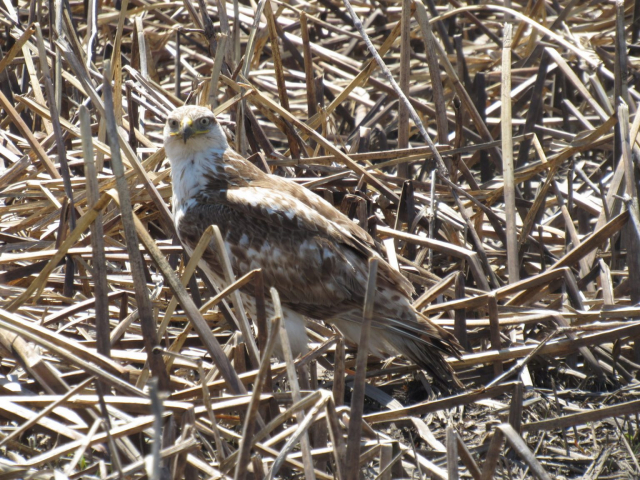Buteo regalis
Status: Uncommon regular spring and fall migrant west and central, rare casual east. Uncommon regular breeder west, rare west central. Uncommon regular winter visitor central and west, rare casual east.
Breeding and migration

Winter

Documentation: Specimen: UNSM ZM7687, Stapleton, Logan Co 24 Jan 1935.
Taxonomy: No subspecies are recognized (AviList 2025).
As with Swainson’s Hawk, Ferruginous Hawk has a range of color morphs, including dark, intermediate (rufous), and light, but dark and intermediate birds comprise 5% or less of the breeding population in Colorado (Wheeler 2003). There is some evidence that at certain times and locations the proportion of dark birds in Nebraska may be higher than that indicated by Wheeler; Nebraska Prairie Partners, a partnership between Bird Conservancy of the Rockies and the Nebraska Game and Parks Commission, found a concentration of dark morphs in Morrill Co in summer of 2007 (Bart Bly, personal communication), and about 10% of Ferruginous Hawks found in the winters 1978-79 and 1979-80 along the central Platte River Valley were “dark-phase” birds (Lingle 1989). Additional records of dark birds, all during winter, include a specimen, UNSM ZM7687, taken at Stapleton, Logan Co 24 Jan 1935 (cited above), and singles in Hayes Co 25 Oct 2014, near Keystone, Keith Co 1 Nov 1987 (Rosche 1994), and near Kearney, Buffalo Co 11 Nov 2001, and one of four found on the Lake McConaughy CBC 19 Dec 2005 was a dark bird.
Spring: winter <<<>>> Apr 14, 15, 15
Late dates above are for the east and east central.
Later dates in the east and east central are 22 Apr 2010 Loup Co, 26 Apr 2012 Buffalo Co, 29 Apr 2001 Buffalo Co, 30 Apr 2011 Dakota Co, 3-6 May 2020 Fillmore Co, 5 May 2006 Butler Co, and 11 May 2023 Clay Co.
According to Palmer (1988), most migration occurs in Mar-Apr, with immature non-breeders following later, as late as Jun; one such was in Fillmore Co 3-6 May 2020. Rosche (1994) lists this species as a spring transient in the west 10 Mar-18 May. Many Nebraska breeders may be resident or short-distance migrants (Ng et al 2020).
There is only one eastern spring record with photos: a light morph juvenile in Lancaster Co 15 Apr 2018.
Summer: The breeding range in Nebraska is limited to the western third of the state, where densities are highest in the western Panhandle north and south of the North Platte River, although nesting has occurred east to Hooker, Lincoln, Hayes and Dundy Cos (Ducey 1988, Johnsgard 1997). There is also a credible report, albeit with limited details, of nesting in 1979 near Axtell, Phelps Co (NGPC, unpublished data).
Ferruginous Hawk was apparently formerly more widespread and numerous; Bruner et al (1904) stated that it bred in “moderate numbers in the Sandhills, and commonly along the Pine Ridge and about the buttes of western and northwestern Nebraska”. A nest with eggs was near Long Pine, Brown Co 10 Jun 1898 (W. C. Smith; Mollhoff 2022). Photographs of a nest with eggs at Fort Niobrara NWR, Cherry Co 10 May 1921 is at the Littleton Museum, Littleton, Colorado (eBird.org). Subsequently, though, numbers declined, its range was reduced, and, by the 1970s, NGPC considered it a species of “unknown status” (Wingfield 1985). By 1980, the Ferruginous Hawk breeding range was believed to be limited to northwest Nebraska (Johnsgard 1980). Surveys conducted by NGPC (with USFWS in 1983-84) from 1981-88 located 21 nest sites by 1983 and that number reached 30 in 1986 and 1987 (Carlson et al 1983, 1984; Wingfield 1985, 1986, 1987, 1988). Out of 62 eyries identified by NGPC by 1988, 30 were in Sioux Co, followed by Box Butte (13), Dawes (7), Kimball (7), Banner (1), Dundy (1), Hayes (1) and Lincoln (1) Cos. The estimate provided by Wheeler (2003) and attributed to the USFWS of 35 breeding pairs in Nebraska in 1992 is likely based on these surveys in the 1980s. No details were located regarding an eyrie reported from near Halsey, Thomas Co.
Surveys by Nebraska Prairie Partners (2008) found 21 and 29 occupied nests in 2007 and 2008, respectively, with at least 69 chicks in the Panhandle in 2007, most of those in Kimball Co and along the Niobrara River. These results, when compared to those surveys conducted in the 1980s suggest Ferruginous Hawk numbers and distribution have remained relatively stable in recent decades.
There are additional breeding season reports at the eastern edge of the range outlined above for Frontier and Red Willow Cos north of McCook 2 and 27 Jun 2025, Valentine NWR, Cherry Co 4 Jun 2022, Brown Co 5 Jun 1982 (Brogie and Mossman 1983), Lincoln Co 22 Jun 2024, Keya Paha Co 23 Jun 1962, Hultine WPA, Clay Co immature 30 Jun 2013, northeastern Cherry Co 6 Jul 2023, Polk Co 23 Jul 1985, and 30 Jul 2023 Keya Paha Co. The specimen cited above, collected in Lancaster Co 10 Jun 1894, was taken at a time when grassland was probably more extensive than now.
A female banded in Jan 2004 near Janos, northern Mexico, summered in 2004 in western Nebraska (http://ferruginoushawk.org).
- Breeding phenology:
Incubation/Eggs: 26 Mar- 19 Jun (Mollhoff 2022)
Nestlings: 5 Jun- 22 Jun
Fledglings: 5-15 Jul
Fall: Oct 3, 3, 3 <<<>>> winter
Early dates above are for the eastern half of Nebraska.
Earlier dates for the eastern half of Nebraska are 16 Sep 2000 Wheeler Co, 16 Sep 2014 Kearney Co, 17 Sep 1997 Polk Co (see below), 19 Sep 2017 Harlan Co, 21 Sep 2020 Brown Co, 23 Sep 1995 Greeley Co, 29 Sep 2007 Brown Co, and 29 Sep 2018 Kearney Co.
Young birds may wander widely as early as 40 days after fledging (Palmer 1988), which would allow for sightings as early as early Aug in areas where breeding was not noted (Ng et al 2020).
The only documented fall records in the east are of an immature picked up near Osceola, Polk Co prior to 17 Sep in 1997 and taken to the Lincoln Rehabilitation Center (Omaha World Herald), a light-phase adult near Niobrara, Knox Co 3 Oct 1998 (Brogie 1999), an immature observed for two hours in Douglas Co 19 Oct 2007, a juvenile near Niobrara, Knox Co 26 Oct 2012, an adult in Knox Co 15 Nov 2009, and a light morph juvenile at Eppley Airfield, Omaha, Douglas Co 18 Nov 2015.
One banded in Alberta, Canada, 2 Jul 1936 was shot in Lincoln Co 12 Oct 1937 (Tout 1947), and a juvenile telemetered in 2007 in North Dakota died in southwest Nebraska in late Nov the same year; its device was recovered from an adjacent badger hole. A fledgling transmittered in Washington state in summer 2024 made its way to Alberta, Canada, then Perryton, Texas, and Lamar, Colorado, and then southwestern Nebraska prairie-dog towns until at least 28 Feb 2025.
- High counts: 10 between Merriman and Ainsworth 24 Nov 1994, 7 at one prairie dog town near Kearney 8 Dec 1996, and 5 seen in southwest Nebraska in 600 miles of driving 21-22 Oct 2004.
Winter: Wintering birds occur over at least the western two thirds of the state, often near prairie dog towns; the easternmost regular wintering is near prairie dogs at Prairie Dog WPA and Lindau WPA, both in Kearney Co, although there are several recent records since 2010 in Clay Co and Fillmore Cos, notably at Hultine WPA, Clay Co. Jorgensen (2012) considered Ferruginous Hawk accidental in winter in the eastern Rainwater Basin, citing two records, 2 Jan 1956 Adams Co, and a specimen, UNSM ZM17439, collected near Hastings, Adams Co 24 Jan 1993.
In the east, there have been only four documented winter (3 Oct-15 Apr) reports since 2000: an immature was photographed in Douglas Co 9 Jan 2023, an immature was photographed in Dakota Co 18 Jan 2023, a “dark juv.” was at Branched Oak Lake, Lancaster Co 12 Feb 2016, one was at Hultine WPA, Clay Co 3-25 Mar 2023, and one was at Moger WPA, Clay Co 6 Mar 2023.
Most breeders in the northwest depart in fall; Rosche (1982) considered Ferruginous Hawk only a “casual winter visitant” in the northwest.
Images
Abbreviations
CBC: Christmas Bird Count
NGPC: Nebraska Game and Parks Commission
NWR: National Wildlife Refuge
UNSM: University of Nebraska State Museum
USFWS: United States Fish and Wildlife Service
WPA: Waterfowl Production Area (Federal)
Literature Cited
AviList Core Team, 2025. AviList: The Global Avian Checklist, v2025. https://doi.org/10.2173/avilist.v2025.
Brogie, M.A. 1999. 1998 (Tenth) Report of the NOU Records Committee. NBR 67: 141-152.
Brogie, M.A., and M.J. Mossman. 1983. Spring and summer birds of the Niobrara Valley Preserve, Nebraska: An annotated checklist. NBR 51: 44-51.
Bruner, L., R.H. Wolcott, and M.H. Swenk. 1904. A preliminary review of the birds of Nebraska, with synopses. Klopp and Bartlett, Omaha, Nebraska, USA.
Carlson, D., J. Dinan, and G. Wingfield. 1983. Ferruginous Hawk nesting and productivity 1983 summary. Nebraska Game and Parks Commission report, Lincoln, Nebraska, USA.
Carlson, D., J. Dinan, and G. Wingfield. 1984. Ferruginous Hawk nesting and productivity, 1984. Nebraska Game and Parks Commission report, Lincoln, Nebraska, USA
Ducey, J.E. 1988. Nebraska birds, breeding status and distribution. Simmons-Boardman Books, Omaha, Nebraska, USA.
Johnsgard, P. A. 1980. A preliminary list of the birds of Nebraska and adjacent Great Plains states. Published by the author, University of Nebraska, Lincoln, USA.
Johnsgard, P.A. 1997. The birds of Nebraska and adjacent plains states. Occasional Papers No. 6, Nebraska Ornithologists’ Union. Lincoln, Nebraska, USA.
Jorgensen, J.G. 2012. Birds of the Rainwater Basin, Nebraska. Nebraska Game and Parks Commission, Lincoln, Nebraska, USA.
Lingle, G.R. 1989. Winter raptor use of the Platte and North Platte River valleys in south central Nebraska. Prairie Naturalist 21: 1-16.
Mollhoff, W.J. 2022. Nest records of Nebraska birds. Nebraska Ornithologists’ Union Occasional Paper Number 9.
Nebraska Prairie Partners. 2008. Western Nebraska Final Nebraska Environmental Trust Research Report-2005-07. Bird Conservancy of the Rockies, Brighton, Colorado, USA.
Ng, J., M.D. Giovanni, M.J. Bechard, J.K. Schmutz, and P. Pyle. 2020. Ferruginous Hawk (Buteo regalis), version 1.0. In Birds of the World (P. G. Rodewald, Editor). Cornell Lab of Ornithology, Ithaca, NY, USA. https://doi.org/10.2173/bow.ferhaw.01.
Palmer, R.S., ed. 1988. Handbook of North American birds. Vol. 4. Diurnal Raptors (Part 1). Yale University Press, New Haven, Connecticut, USA.
Rosche, R.C. 1982. Birds of northwestern Nebraska and southwestern South Dakota, an annotated checklist. Cottonwood Press, Crawford, Nebraska, USA.
Rosche, R.C. 1994. Birds of the Lake McConaughy area and the North Platte River valley, Nebraska. Published by the author, Chadron, Nebraska, USA.
Tout, W. 1947. Lincoln County birds. Published by the author, North Platte, Nebraska, USA.
Wheeler, B.K. 2003. Raptors of Western North America. Princeton University Press, Princeton, New Jersey, USA.
Wingfield, G. 1985. Ferruginous Hawk nesting and productivity, 1985 summary. Nebraska Game and Parks Commission report, Lincoln, Nebraska, USA.
Wingfield, G. 1986. Ferruginous Hawk nesting and productivity, 1986. Nebraska Game and Parks Commission report, Lincoln, Nebraska, USA.
Wingfield, G. 1987. Ferruginous Hawk nesting and productivity, 1987. Nebraska Game and Parks Commission report, Lincoln, Nebraska, USA.
Wingfield, G. 1988. Ferruginous Hawk nesting and productivity, 1988. Nebraska Game and Parks Commission report, Lincoln, Nebraska, USA.
Recommended Citation
Silcock, W.R., and J.G. Jorgensen. 2025. Ferruginous Hawk (Buteo regalis). In Birds of Nebraska — Online. www.BirdsofNebraska.org
Birds of Nebraska – Online
Updated 24 Aug 2025




